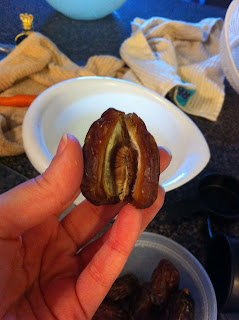A lot of people eat their citrus fruit and throw the rinds away. This is a shame. Here is a quick and easy way to turn your grapefruit, orange and lemon peels into a delicious candy.
What you'll need:
some type of citrus fruit, I used a grapefruit
sugar
water
parchment or wax paper
A quick note. It helps to use organic fruit that you know isn't coated in wax.
First I cut the grapefruit in half to eat. Then I took the peel, insides down, and cut it into strips with a pairing knife. I put the strips in a pot and covered them with cold water and put them on the stove to boil.
After it comes to a boil, drain the pot and start the boiling process all over, putting the rinds in the pot and covering with cold water. Do this about three to five times. The more you do this, the less bitter the candy will be.
Then drain the pot a final time. At this point I took the pairing knife and cut off the remnants of the pith and any leftover fruit. You can see here a quick before (right) and after (left).
In the same pot, I heated up one part water to two parts sugar. For this recipe I had 1 cup of water and 2 cups of sugar. Heat this mixture for about 15 minutes until it is syrupy. Then add the strips back and cook for about an hour.
Make sure during this hour that your syrup doesn't dissolve, burning your pot and the rinds.
After an hour, I used tongs and put the strips on parchment paper to dry. The fruit should be glistening and a little see through. Make sure the pieces aren't touching.
This drying process takes about 24 hours. I turned them once just to make sure the bottom sides dried.
I love these candies. They taste like healthy gummy bears or Swedish fish. They last for quite a while too, but I bet you'll eat them all before they go bad.
What you'll need:
some type of citrus fruit, I used a grapefruit
sugar
water
parchment or wax paper
A quick note. It helps to use organic fruit that you know isn't coated in wax.
First I cut the grapefruit in half to eat. Then I took the peel, insides down, and cut it into strips with a pairing knife. I put the strips in a pot and covered them with cold water and put them on the stove to boil.
After it comes to a boil, drain the pot and start the boiling process all over, putting the rinds in the pot and covering with cold water. Do this about three to five times. The more you do this, the less bitter the candy will be.
Then drain the pot a final time. At this point I took the pairing knife and cut off the remnants of the pith and any leftover fruit. You can see here a quick before (right) and after (left).
In the same pot, I heated up one part water to two parts sugar. For this recipe I had 1 cup of water and 2 cups of sugar. Heat this mixture for about 15 minutes until it is syrupy. Then add the strips back and cook for about an hour.
Make sure during this hour that your syrup doesn't dissolve, burning your pot and the rinds.
After an hour, I used tongs and put the strips on parchment paper to dry. The fruit should be glistening and a little see through. Make sure the pieces aren't touching.
This drying process takes about 24 hours. I turned them once just to make sure the bottom sides dried.
I love these candies. They taste like healthy gummy bears or Swedish fish. They last for quite a while too, but I bet you'll eat them all before they go bad.


















































